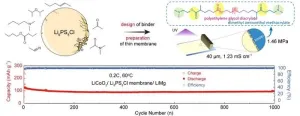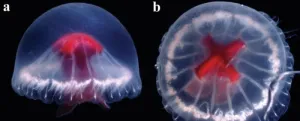They published their work on Feb. 2 in Energy Material Advances.
"The development of thin sulfide solid electrolyte layers is imperative" said paper author Xiayin Yao, a professor at the Laboratory of All-solid-state rechargeable battery, Ningbo Institute of Materials Technology and Engineering, Chinese Academy of Sciences (CAS). "Although sulfide solid electrolyte is easy densified through cold pressing method, the freestanding membrane generally show a thickness greater than 500 μm. The thick and heavy layer of sulfide electrolyte results in less than expected cell-level energy density."
Yao explained that the difficulty in developing ultra-thin sulfide electrolyte membranes, suffering fracture during the cycle due to its brittleness nature, leading to short circuit of the battery.
"Inspired by the binder-assisted electrode fabrication in conventional lithium-ion batteries,” Yao said. “Combining polymeric binders with sulfide solid electrolytes is a promising strategy to prepare thin sulfide solid electrolyte layers with high mechanical strength."
Nevertheless, a slurry-based system has not yet been totally established due to the sensitivity character of sulfide solid electrolyte particle. Generally, a desirable polymeric binders should possess sufficient adhesion capability to adapt the volume changes during cell cycling while maintaining the performance of the sulfide solid electrolyte. Meanwhile, considering the chemical instability of sulfide solid electrolytes, the solvents are restricted to weakly polar organic solvents, such as toluene, xylene, heptane, ethyl acetate, etc. It is difficult to balance the stability and suitable adhesion between sulfide solid electrolyte particles and polymeric binders.
"The design of polymer binders with suitable solvents is rarely reported for the preparation of sulfide solid electrolyte membranes through wet method." Yao said. "The polarity of solvent is the primary factor to consider its compatibility with sulfide solid electrolyte, which is related to the functional groups contained and the structure of molecular. However, for different sulfide solid electrolytes, the polarity cannot reflect the same compatibility of electrolyte with solvents."
"Clearly, it is urgent to develop advanced binders with suitable solvents to realize ultrathin, robust, and highly ionic conductivity sulfide solid electrolyte membranes." Yao said. "In this paper, the interaction among solvents containing different functional groups with the Li6PS5Cl solid electrolyte were explored and a new polymeric binder with superior mechanical properties and excellent stability to Li6PS5Cl was designed."
"Different from previous conventional binders, the precursors of polymer binder are easily dispersed in anhydrous acetonitrile. Through in-situ photo-polymerization, a free-standing Li6PS5Cl thin membrane with room temperature ionic conductivity of 1.23 mS cm−1 can be prepared." Yao said.
"The assembled LiCoO2| Li6PS5Cl membrane| LiMg all-solid-state battery can stably cycle 1000 cycles at 0.2C under 60oC." Yao said. The pouch-type cells still exhibit outstanding electrochemical performance when increasing the mass loading of active materials up to 15.2 mg cm−2, which provides a new slurry-based system for the preparation of Li6PS5Cl electrolyte thin membrane in all-solid-state batteries.
Yao is also affiliated with the University of CAS Center of Materials Science and Optoelectronics Engineering. Other contributors include Xiaolei Zhao, Lin Shen, Nini Zhang, Jing Yang, Gaozhan Liu and Jinghua Wu, the Laboratory of All-solid-state rechargeable battery, Ningbo Institute of Materials Technology and Engineering, CAS.
The following authors have additional affiliations: Xiaolei Zhao and Nini Zhang, University of CAS Center of Materials Science and Optoelectronics Engineering.
The National Key R&D Program of China (Grant no. 2022YFB3807700), National Natural Science Foundation of China (Grant no. 22309194, 52372244), Ningbo S&T Innovation 2025 Major Special Programme (Grant No. 2021Z122, 2023Z106), Zhejiang Provincial Key R&D Program of China (Grant No. 2022C01072), Jiangsu Provincial S&T Innovation Special Programme for carbon peak and carbon neutrality (Grant No. BE2022007) and Youth Innovation Promotion Association CAS (Y2021080) supported this work.
##
INSERT BOILERPLATE
Reference
Authors: Xiaolei Zhao, a, b Lin Shen, a Nini Zhang, a, b Jing Yang, a Gaozhan Liu, a Jinghua Wu, a and Xiayin Yao, a, b
Title of original paper: Stable Binder Boosting Sulfide Solid Electrolyte Thin Membrane for All-Solid-State Lithium Batteries
Journal: Energy Material Advances
DOI: 10.34133/energymatadv.0074
Affiliations:
a Ningbo Institute of Materials Technology and Engineering, Chinese Academy of Sciences, Ningbo 315201, P.R. China, Chinese Academy of Sciences, Ningbo 315201, P.R. China
b Center of Materials Science and Optoelectronics Engineering, University of Chinese Academy of Sciences, Beijing 100049, P.R. China
A brief introduction of the Author
Xiayin Yao is a professor at Ningbo Institute of Materials Technology and Engineering, Chinese Academy of Sciences (NIMTE, CAS). He received Ph.D from Institute of Solid State Physics and NIMTE, CAS in 2009. After that, he joined NIMTE and worked there until now. He worked as a research fellow or visiting scholar in Hanyang University, S. Korea (2012-2013), Nanyang Technological University, Singapore (2013-2014) and University of Maryland, College Park, USA, (2018-2019). So far, he has coauthored over 200 peer-reviewed journal papers and applied more than 80 Chinese patents. His major interests include developing solid state electrolytes with high ionic conductivities and solid-state lithium-sulfur batteries as well as solid-state sodium batteries.
END


